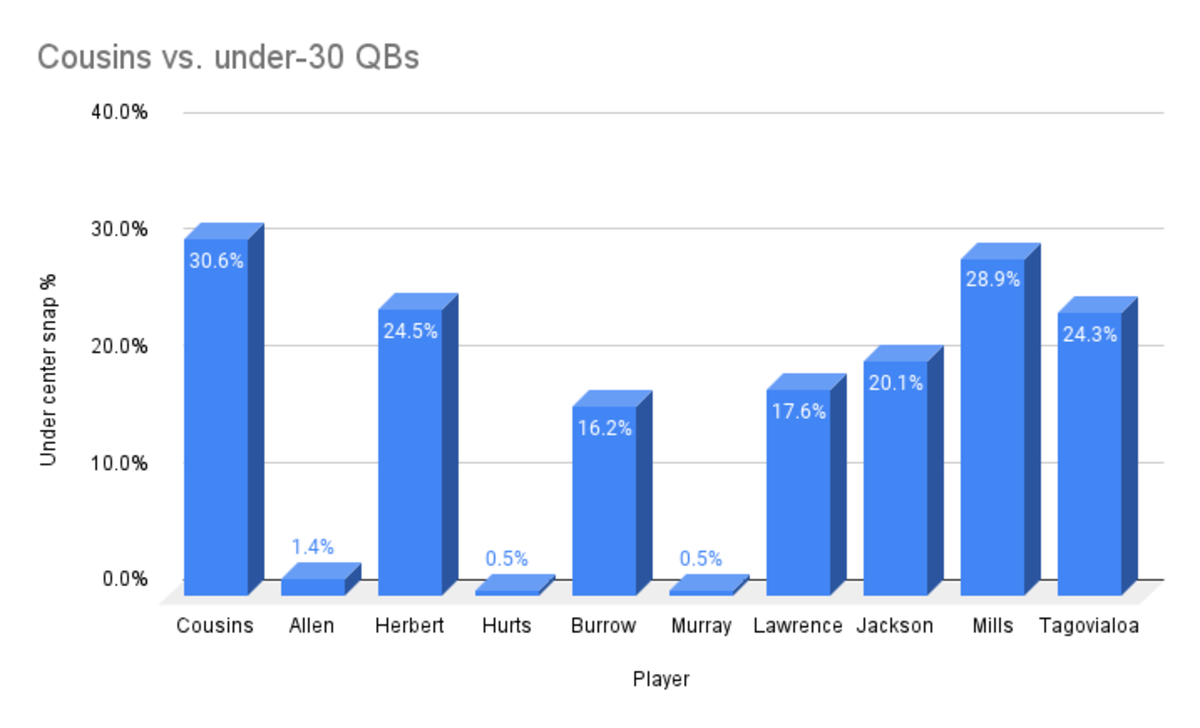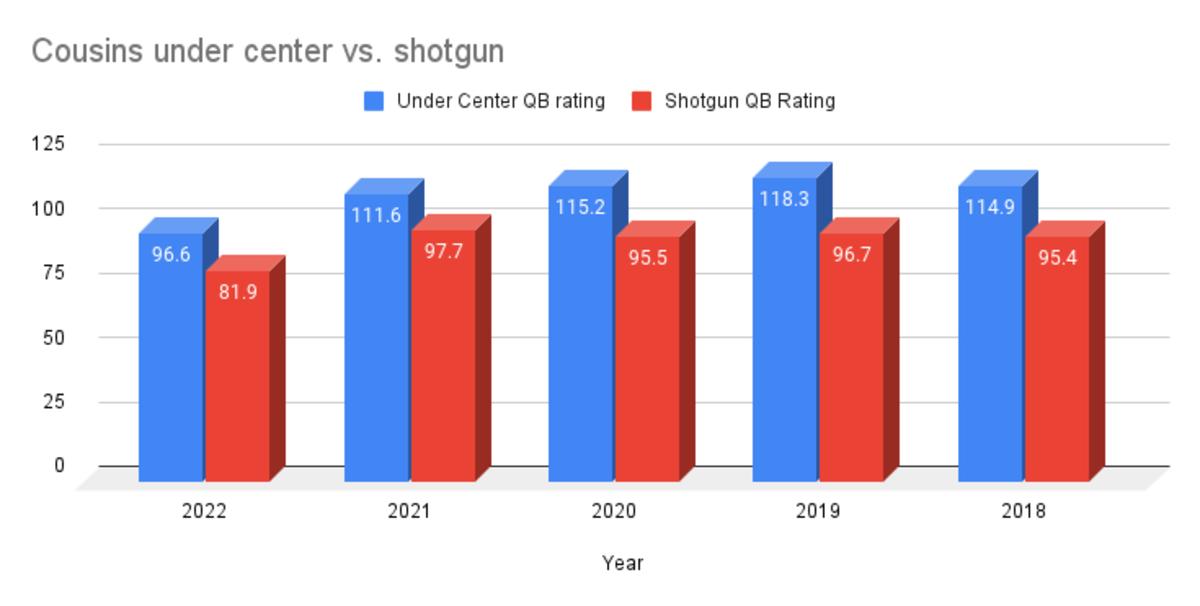Kirk Cousins: The last under-center quarterback

EAGAN — In the late-80s, NFL Films produced a feature called “Quarterbacking by Bill Walsh,” in which the legendary coach and Hall of Fame quarterback Joe Montana go through proper techniques for everything from the three-step drop to the third read in his progression. The piece provides incredible insight into how Walsh made the West Coast San Francisco 49ers’ offense work so masterfully. Everything was timing and footwork.
“One of the great assets Joe had as a quarterback is that he could get away from center so well,” Walsh tells the NFL Films cameras.
On throws to the right, Walsh emphasizes that Montana must keep his helmet straight forward until he’s ready to release the ball to avoid telegraphing the pass. He tells his QB to make his steps as quick as possible on the five-step drop and angle his front foot slightly to the right at the release to get his momentum going in the proper direction. All the receivers’ patterns were built around the depth of dropbacks and Montana’s ability to get it exactly right time and time again.
Every demonstration in the 43-minute video, including reproducing Montana’s famed throw to Dwight Clark to beat the Dallas Cowboys in the 1981 playoffs, has Montana taking the snap under center.
Passing the ball from under center has largely become a relic in the NFL. Per SharpFootballStats, in 2020 75% of passes were thrown from the shotgun. Particularly as college quarterbacks come into the NFL from spread offenses, the trend is likely to push Walsh’s under-center details farther to the backburner.
But Minnesota Vikings quarterback Kirk Cousins, who is old enough to have seen some Montana games as a kid, is going against the NFL grain when it comes to playing under center. This year he’s thrown 31% of his passes from the traditional look and in 2019 and 2020 that number was close to 40%. After Sunday’s game in which the Vikings opened the game with repeated under-center plays, Cousins’ under center usage is creeping back up toward levels that would make Gary Kubiak proud.
Here’s how Cousins compares to the top under-30 quarterbacks in percentage of pass attempts thrown while under center:

As you can see, quarterbacks with a running element to their game are barely throwing the ball under center at all, while there is a flicker from the youthful pocket QBs. But nobody except Davis Mills, who came from an under-center college program at Stanford, approaches Cousins.
Vikings head coach Kevin O’Connell is all for it.
“We have a lot of things at our disposal under center in our offense where we can maximize the deception of what we’re trying to do based upon marrying the run and the pass,” O’Connell said. “It’s way easier to do it if you’re under center and you can handle more of the workload under center and there’s some fundamental things quite honestly nowadays quarterbacks just don’t get to do a lot of coming up through spread offenses.”
Since arriving in Minnesota, Cousins’ numbers under center are nothing short of outstanding.

The play-action game, which was used on 17 of Cousins’ 43 dropbacks against the Bears, has long been a major strength of Cousins and certainly plays into the boosted stats from under center. While the Vikings can still use play-action out of the shotgun, it has been particularly effective when using traditional running formations with a tight end and fullback in play, like they did it in Montana’s day.
“If you’ve got a quarterback who has the ability like Kirk to turn his back to the defense and really set that fake in there, sometimes you can get those guys stepping up a little more and kind of get the guys behind them like you want,” offensive coordinator Wes Phillips said.
So what makes Cousins a master of the under-center game compared to his peers? If it’s working for him, why aren’t others making it work for them?
Well, that’s because it isn’t easy.
“You’ve got to be willing to turn your back to the defense on play pass and then trust when you turn back around, you can make the same type of decisions within the rhythm and timing of plays just like you would in the gun,” O’Connell said. “Also, knowing you’re that much closer to the rush, you have to have the ability to get away from the line of scrimmage, especially when we drop back, throw quickly, throw balls down the field.”
Quarterback Nick Mullens, who was under center 29% of time when he started for San Francisco in 2020, said that things look different when moving backward with the ball as opposed to standing in the shotgun.
“You are moving while you are seeing a picture compared to shotgun where you have more space and you aren’t moving as much,” Mullens said. “Some might say that the picture looks more clear from shotgun to start. I enjoy doing both. There is a time and a place for both as far as play specific and rhythm. Some route combinations are better, some have more tempo and rhythm when going under center.”
Detailed footwork, as Walsh was teaching the NFL Films audience, is everything when playing from under center. There are few more accurate QBs throwing the ball when they are on a bootleg or when they set their feet and make an in rhythm throw than Cousins, which gives him an edge.
“If you watch a quarterback’s feet you can feel how his mind is working, if that makes sense,” Mullens said. “If he’s got calm rhythmic feet then he is probably playing with a clear and calm mind, that’s what I’ve always believed in. The very good quarterbacks in this league have good arm talent but they also have very good feet, calm feet, very consistent feet, they aren’t all over the place. I’m a big believer in keeping your base to be able to always throw from.”
As well as it all works for Cousins and the Vikings to be under center, they can’t lean too far into it because there are some drawbacks. If the opposing team has a good pass rush, particularly on the interior, it can undo dropbacks pretty quickly. When opposing teams know it’s a passing situation, they can rush up the field and the play-action isn’t a factor.
That’s why, in a passing league, the run game still plays a significant role when you have an under-center QB.
“It feels like you can navigate the offense on your terms compared to where if…we can’t run the ball, they know we’re passing…that’s a situation you don’t want to be in,” Mullens said. “If you have a good run game that’s a quarterback’s best friend because it makes everything more comfortable.”
The use of the under-center offense will need to be part of the growing process between Cousins and O’Connell. Last week Cousins said following the win over the Bears that his interception came on a play that he might have read differently in the past — so it’s not exactly all the same Bill Walsh, Mike Shanahan, Gary Kubiak and Kevin Stefanski stuff from the past. But it may be the key between the Vikings having a good and great passing game.
“It helps us a ton and it’s something we don’t take lightly,” O’Connell said.
Related: Reports: Tua Tagovailoa likely out, Dolphins optimistic about Tyreek Hill
Related: Vikings PFF grades: The good and bad against Chicago
